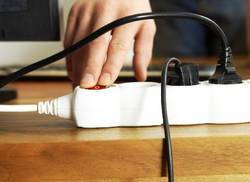Categories: Featured Articles » Electrician Secrets
Number of views: 69067
Comments on the article: 8
Broken common neutral wire in the access electrical panel: danger of overvoltage
 Why can a broken common ground wire in the access electrical panel cause an increase in the mains voltage? How is this dangerous? How to avoid this?
Why can a broken common ground wire in the access electrical panel cause an increase in the mains voltage? How is this dangerous? How to avoid this?
Excess voltage in a household electrical network - not at all uncommon. Instead of rated 220 volts, much more can happen in apartment outlets. There may be many reasons for this, but the most common is breakage of the common zero working wire in the access switchboard.
Residential apartment buildings are usually powered by a three-phase 380 V network with a dullly grounded neutral. This means that at the entrance to all floors stretch “risers” - vertically laid wires of large cross-section.
There are at least four such wires — three phases and a working “zero” connected to the grounded neutral point of the supply transformer, whose windings are connected to a “star”. In new homes there is also a fifth wire - a protective "zero", designed to ground luminaires and housings of household appliances.
Between any of the phase wires and the neutral wire there is a constant potential difference - 220 V, and this position does not depend on the asymmetry of the load. That is, regardless of how many apartments are powered by each phase and how many electrical appliances are currently on in each of these apartments, the voltage in each outlet will always be the same. This is ensured by the fact that the potential of the neutral wire is tied to the potential of the earth, conditionally assumed to be zero and cannot be changed.
But if a zero working wire suddenly breaks off in the common entrance electrical panel (for example, it burns out or falls off due to poor-quality installation), the picture changes significantly. Now the zero wires of all apartments connected to this shield do not have any electrical connection to the ground, and, therefore, their potential can change.
Figuratively speaking, the electric current, not having the opportunity to go to the grounded neutral point of the transformer, “seeks its own way more freely”. He seems more free dear phasein which many consumers are included, and in which the electrical resistance of the wiring is currently small. In such a phase, when the common ground wire is torn off, the current will be large, and the voltage will “sink”, decrease, and the potential of the neutral point of the network will “go sideways”.
If something decreases somewhere, then it always arrives in another place - this is an undeniable law of nature. Here, in this case, a decrease in voltage in one phase threatens to increase it in another, less loaded. This ends, of course, disastrously. In apartments connected to the unfortunate phase, which is experiencing increased voltage, in the literal sense of the word, household appliances are burning, lamp lamps are out of order, and even a fire is possible. Watch - What happens on the network when a zero break occurs (vector diagrams of normal and emergency modes).
To avoid these troubles, it is necessary to monitor the condition of the electric risers and input cables. This applies, first of all, to housing and communal services workers who are responsible for the good condition of the electric facilities. But the owners of residential premises should not rely on someone's vigilance.
As one of the precautionary measures, you can offer installation in electrical panels individual modular surge arresters. Such a device will not allow your equipment to burn from a voltage surge, including that caused by a break in the common zero wire.
See also on this topic:How to protect the apartment from overvoltage
Alexander Molokov
See also at e.imadeself.com
:
